 My wife and I were after dinner, mambo dancing to Kid Creole And The Coconuts… as we often do, when I got to thinking about how, when it comes to firearms, “new” is a big draw. Why not? It is fun to wring out a new combination, handload a new cartridge and the experience provides one more reason to talk about and shoot firearms. I have to sit down. Too many chairs to dodge in the living room and I believe I’ve sustained a serious hip injury.
My wife and I were after dinner, mambo dancing to Kid Creole And The Coconuts… as we often do, when I got to thinking about how, when it comes to firearms, “new” is a big draw. Why not? It is fun to wring out a new combination, handload a new cartridge and the experience provides one more reason to talk about and shoot firearms. I have to sit down. Too many chairs to dodge in the living room and I believe I’ve sustained a serious hip injury.
The perspective on hunting firearms is a bit different. Hunting is expensive, sometimes to the extreme, and often takes a large investment in time and effort. Rural and/or /remote locations are not typically big on stocking new/oddball ammunition or being able to service new and/or unique firearms. Planning helps, but there is no accounting for an airline taking your 28 Nosler ammo to the Bahamas after dropping you and your rifle off in Pakistan for your long awaited Ibex hunt or looking for a shop to repair the selector on your Purdey side X side in Buford, Wyoming.
A reliable choice does not mean boring
Winchester does an excellent job of placing firearm history in a modern package. The Winchester Model 70 was introduced in 1937, replaced the company’s Model 54. The Featherweight version of the Model 70 arrived in 1952 as a lighter hunter’s rifle at seven and one-half pounds; light within the context of rifles of that day.
|
Winchester Model 70 Featherweight |
|
| Manufactured | Browning – Portugal |
| Item# | 535236226 |
| Type | Bolt Action |
| Caliber | 270 Winchester |
| Capacity | 5+1 |
| Barrel Length | 22″ |
| Rifling | 1:10 RH |
| Weight | 7 Lbs 0 Oz |
| Overall Length | 42 3/4″ |
| Stock | AAAA Dark Maple |
| Barreled Action | Stainless Steel |
| Length of Pull | 13 3/4″ |
| Drop at comb | 1/2″ |
| Drop at heel* | 3/4 “ |
| Sights | Clean |
| Scope | Drilled and Tapped |
| Trigger Pull | 4 Lbs. 2 Oz. Adj |
| Safety | Wing Three Position |
| U.S. MSRP | $1529.99 |
The subject rifle is chambered for the 270 Winchester cartridge, but the model is also available in 243 Win, 308 Win, 30-06 Springfield, 264 Win Mag, 7mm Rem Mag, and 300 Win Mag. A broad hunting cartridge selection.
The current Winchester Model 70 in very much the same design as the original Model 70 right down to its pre-’64 controlled round feed action. However, it has also received the benefits of improve manufacturing processes, the precision of CNC machining, enhanced material selection, and the vastly improved proprietary M.O.A. Trigger System. This particular version has a AAAA Dark Maple stock, an enhancement over standard Featherweights.
I won’t call it a tiger tail grain structure and coloring, but I would call it a fancy grade dark maple with lots of subtle, contrasting fiddleback grain that runs from recoil pad to Schnabel forend. I have not been a fan of maple stocks over the years, but that was based on light birdseye and curly maple, wood I find monotonous. The dark maple used on this model is quite attractive and makes for a nice alternative to walnut.
The Winchester Model 70 Featherweight has a quiet, three position wing safety; safe with bolt locked in closed breech, safe with ability to cycle bolt to clear rifle, fire. The metal work is very clean from the bolt jeweling to the anti slip knurled pattern on the bolt knob. No rough edges, no rounded corners or edges from sloppy buffing wheel finishing, no unevenness anywhere in the satin finish. The stainless is bright, but not really reflective. The 20 lpi checkering patterns are traditional featherweight types and well executed.
The forearm bottom side contour is hand filling where it needs to be and slender where it looks aesthetically correct and saves weight. The Schnabel forend is a nice touch. It has classic rifle appeal and it is fun to say as a study in accents from the old TV show, Hogan’s Hero’s. Winchester has come a long way with their checkering in recent years. For a while, cutting left the points as… points that picked up any kind of fuzz from wiping cloths and had some mild cheese greater effect, particularly in heavy recoiling rifles. Patterns on the dark maple stock and others are precise in placement and depth, points are fully formed and make as excellent gripping surface. Some other manufacturers are still struggling with computer controlled laser etched checkering machinery, Winchester is not
The Winchesters bottom metal metal is a combination of anodized aluminum alloy for the trigger guard and floorplate hinge frame and steel for the floorplate. The follower is stainless steel.
Returning to my original point, conservative choices in firearm and cartridge combination for hunting, for as fancy as the dark maple Featherweight is, at the core it is still a Winchester Model 70 that can be repaired or serviced where ever almost any gunsmith can be found along. Most parts cross fit to most configurations of Model 70 rifles, virtually all cross fit to other model Model 70 Featherweights.
The 270 Winchester. You may have heard of it…
 The 270 Winchester has been with us since 1925. Jack O’Connor may have been the journalist who popularized the cartridge, but it is the cartridge’s ballistic performance that has kept it a popular cartridge for hunters, forty years after O’Connor’s passing. The 270 Winchester can fit many hunting applications all the way up to moose and elk. When firearm manufacturers introduce new models, they are always chambered in the big three; 30-06 Springfield, 308 Winchester and 270 Winchester.
The 270 Winchester has been with us since 1925. Jack O’Connor may have been the journalist who popularized the cartridge, but it is the cartridge’s ballistic performance that has kept it a popular cartridge for hunters, forty years after O’Connor’s passing. The 270 Winchester can fit many hunting applications all the way up to moose and elk. When firearm manufacturers introduce new models, they are always chambered in the big three; 30-06 Springfield, 308 Winchester and 270 Winchester.
Currently, there are approximately fifty-five factory loads available for 270 Winchester, including ten leadless for folks who live outside of the free United States. Bullet weight ranges from 100 grains for varmint to the core 130, 140 and 150 grain for medium through big game hunting. Bullet construction is commensurate with hunting application. Subsequently, even rural gun stores stock 270 Winchester ammunition and even during periods of ammunition shortages, 270 Winchester ammunition has been available as an essential cartridge.
If there is an oddity in the 270 Winchester universe it would be the blatant conflict in statements of accuracy. On one had there is a near century long testimony by established big game hunters and writers to four and five hundred yard kills on pronghorn, deer, elk, and moose and rave reviews regarding the cartridge’s long range performance. Yet, there is no match ammo and of the ninety 0.277″ diameter component bullet available to handloaders, only Sierra produces a match bullet for this bore. Perhaps I am overlooking the size of the game in comparison to a target’s bullseye or perhaps hunter’s embellishment?
Personally, I’ve found quality modern 270 Winchester sporter rifles to be accurate and I’ve found few people who own and shoot them to complain about their firearms performance. The answer to the no match bullet issue may be in the 0.277″ bullet’s aerodynamics.
A typical 0.277″, heavy for bore, 150 grain SPBT bullet has a sectional density of 0.279 and a muzzle velocity ballistic coefficient of 0.483. The ratio of grains per thousandth of bullet diameter is 0.54 grains, or the equivalent of a 162 grain .30 caliber bullet. A heavy for bore ,30 caliber bullet can weighs 230 grains or 0.77 grain per thousandths of bullet diameter. Its sectional density if 0.376 and its ballistic coefficient is 0.800.which makes a significant difference in down range retained velocity and bullet stability. To achieve similar form with the 270 Winchester, the bullet would weigh approximately 213 grains and way too long to stabilize in typical 1:10″ rifling… and of course no such bullets exist.
So the 270 Winchester is in accurate? No way…
I think the inaccuracy reputation for the 270 Winchester came from sources like Famous Name Magazine, not to be named, and what they presented as a controlled laboratory assessment of the Winchester’s accuracy… which was mostly not. Not in fixtures, procedures or methodology and certainly not when they declared the 270 Winchester to generally be a 2″ to 2 1/2″ 5 shot group cartridges. If I owned a 270 Winchester that shot that poorly I would turn it into firewood and a table lamp. No long range big game rifle/cartridge combination that shot 2″ to 2 1/2″ groups at 100 yards would persist for a dozen years, much less just shy of a century.
In the case of the Winchester Model 70 Featherweight 270 Winchester, I tried another type of highly controlled testing. I pulled two old boxes of Prvi 130 and 140 grain soft point ammo from of the back of an inventory shelf, both were marked $12.95. I put targets out at 100 yards and shot two, three shot groups. I never shoot five shot groups because statistically they are meaningless and no one I admit knowing shoots game five times.
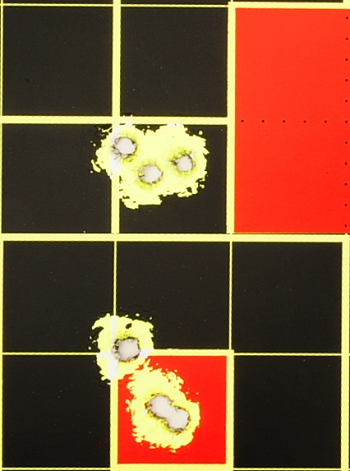
The top 0.5″ group, measured farthest hole center to center. is the Prvi 130 grain, the bottom 0.7″ is the 140 grain Prvi. Other groups, other ammo types, 130 to 150 grain shot roughly the same, with the exception of a 150 grain Nosler Partition round that went 1.1″.
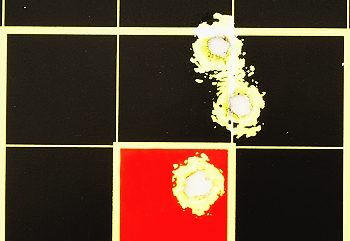
The Winchester Model 70 Featherweight demonstrated excellent accuracy with factory ammunition and, no doubt, could do still better with handloads.
Conclusions?
Beyond balance and fit, two things jumped out while running through this project. The MOA trigger is terrific. Clean, crisp and adjustable to a light pull. The second notable is how smoothly and easily the Winchester fed rounds. On several occasions I found myself chamber checking because so little effort was required for the bolt to pick a round from the magazine and drive it home. The thin contour barrel heated up a bit and it did so quickly, but not to the detriment of accuracy.
The Winchester Model 70 Featherweight in 270 Winchester is the quintessential big game firearm/cartridge combination I referenced in the beginning of this piece. Power, range, reliability, and serviceability make the combination exceptional for the task. Perhaps dark maple and stainless is not the combination for you, but there are walnut and composite stock models of the Featherweight, with both stainless and alloy steel options, in standard and fancy grades. Nice rifle.

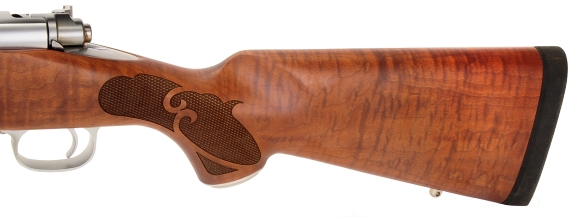
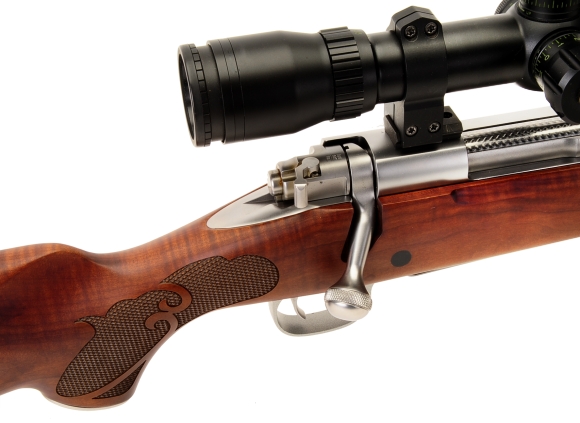
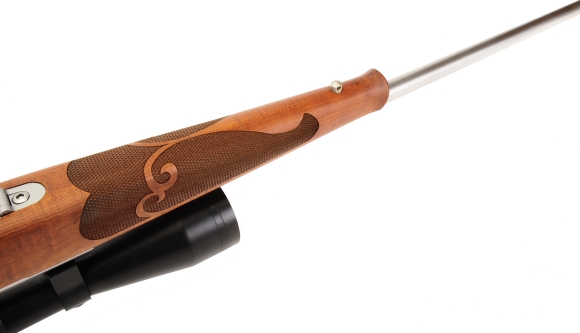
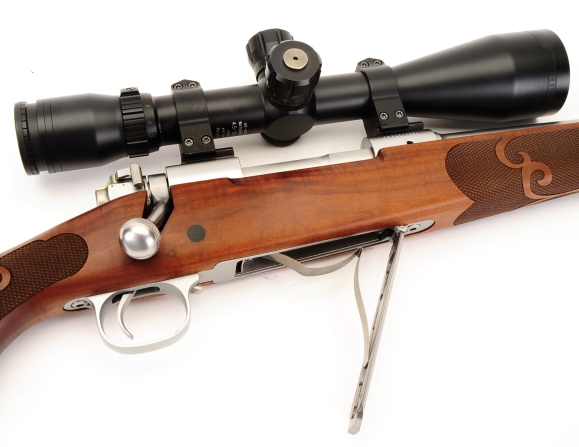

Email Notification